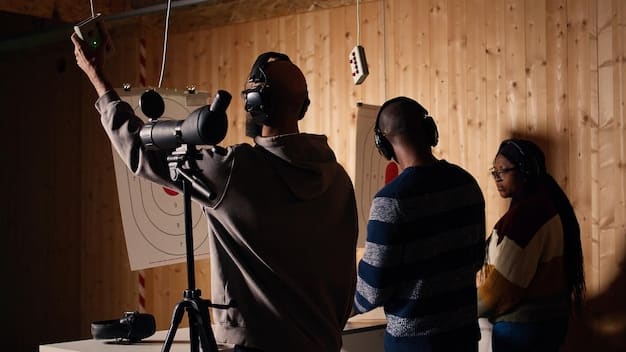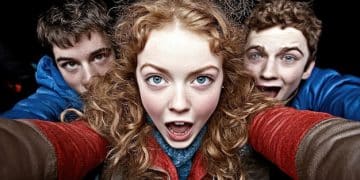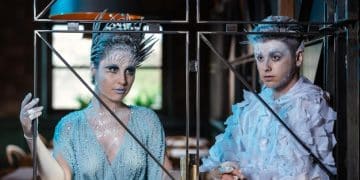The Rise of Diverse Casting in Period Dramas: A 2025 Perspective

The Rise of Diverse Casting in Period Piece Dramas: A 2025 Look at Representation and Authenticity explores how the inclusion of actors from various ethnic backgrounds is reshaping historical storytelling, creating richer, more relatable narratives while sparking important dialogues about historical accuracy and cultural sensitivity.
In recent years, the landscape of period piece dramas has undergone a significant transformation. The Rise of Diverse Casting in Period Piece Dramas: A 2025 Look at Representation and Authenticity is not just a trend, but a conscious shift towards reflecting the multifaceted nature of history itself, prompting both enthusiastic praise and critical debate.
The Evolution of Representation in Period Dramas
Period dramas have long been a staple of television and film, offering viewers a glimpse into bygone eras. Traditionally, these stories were predominantly told through a Eurocentric lens, often overlooking or misrepresenting the experiences of people of color. However, as audiences become more discerning and demand greater inclusivity, the industry is slowly responding.
The move towards diverse casting is not merely about ticking boxes; it’s about enriching the narrative tapestry of these shows. By including actors from various ethnic backgrounds, period dramas can explore the complex social dynamics of the past with greater nuance and authenticity. This shift also allows for a more relatable viewing experience for audiences who have historically been excluded from these narratives.
Breaking Down Barriers: The Impact of Color-Conscious Casting
Color-conscious casting, where actors are cast without strict adherence to the perceived race or ethnicity of historical figures, has been a significant catalyst in this evolution. While this approach has been met with some criticism, it has also opened doors for incredibly talented actors who might otherwise have been overlooked. Furthermore, it allows for a re-examination of historical narratives, challenging ingrained assumptions and biases.
The Authenticity Debate: Historical Accuracy vs. Inclusive Storytelling
One of the central debates surrounding diverse casting in period dramas revolves around the concept of historical accuracy. Some argue that deviating from the perceived demographics of a particular era undermines the integrity of the story, while others contend that strict adherence to historical accuracy can perpetuate harmful stereotypes and exclude marginalized communities.
- Challenging Eurocentric Narratives: Diverse casting provides an opportunity to challenge the dominance of Eurocentric perspectives in historical storytelling, acknowledging the contributions and experiences of people of color.
- Reframing Historical Figures: By casting actors from diverse backgrounds in roles that were traditionally portrayed by white actors, we can encourage viewers to question assumptions about race and power in the past.
- Promoting Cultural Sensitivity: Inclusive casting can help to foster greater cultural sensitivity and understanding by accurately portraying the experiences of different communities in historical contexts.
- Enhancing Audience Engagement: Diverse casting can broaden the appeal of period dramas, attracting a wider audience who feel represented and engaged by the stories being told.
Ultimately, the goal is to strike a balance between historical authenticity and inclusive storytelling, creating narratives that are both informative and engaging for a diverse audience. The debate itself is a valuable exercise in critical thinking, prompting viewers to consider the complexities of history and representation.
Notable Examples of Diverse Casting in Recent Period Dramas
Several recent period dramas have embraced diverse casting to great effect, demonstrating the potential for inclusive storytelling to enhance the viewing experience. These productions have not only garnered critical acclaim but have also sparked important conversations about race, representation, and historical accuracy.
From reimagining classic tales to exploring untold stories from diverse communities, these examples showcase the power of inclusive casting to create richer, more nuanced narratives. They also highlight the growing demand from audiences for period dramas that reflect the realities of our increasingly interconnected world.

“Bridgerton”: A Regency Romance Reimagined
“Bridgerton,” the hit Netflix series, is arguably one of the most prominent examples of diverse casting in recent years. The show, set in Regency-era England, features a predominantly Black aristocracy, a bold and refreshing departure from traditional period dramas. While the show has its detractors who question its historical accuracy, it has also been praised for its lighthearted tone and its commitment to inclusive storytelling.
“Gentleman Jack”: A Lesbian Pioneer’s Story
“Gentleman Jack,” a BBC and HBO co-production, tells the story of Anne Lister, a 19th-century lesbian landowner. The show not only features a compelling portrayal of Lister’s life but also incorporates diverse actors in supporting roles, adding depth and complexity to the narrative.
“The Great”: A Satirical Look at Catherine the Great’s Russia
“The Great,” a satirical comedy-drama about Catherine the Great’s rise to power in Russia, features a diverse cast that reflects the multicultural nature of the Russian Empire. While the show takes considerable liberties with historical accuracy, it also uses its diverse cast to explore themes of power, identity, and representation.
These are just a few examples of the growing trend towards diverse casting in period dramas. As audiences become more discerning and demand greater inclusivity, we can expect to see even more productions that embrace diversity and challenge traditional narratives.
The Business Case for Inclusivity: Why Diversity Matters On-Screen and Off-Screen
Beyond the social and cultural imperatives for diversity, there’s also a strong business case to be made for inclusive casting in period dramas. Studies have consistently shown that diverse casts lead to higher viewership, increased box office returns, and greater overall success.
This is because diverse casts appeal to a broader audience, attracting viewers who have historically been excluded from mainstream narratives. Furthermore, diverse casting can enhance the creative potential of a production, leading to richer storytelling and more compelling characters. In an increasingly competitive entertainment landscape, inclusivity is not just a moral imperative but a strategic advantage.
Expanding the Audience: Reaching Untapped Markets
Diverse casting opens up period dramas to new audiences, including viewers from underrepresented communities who are eager to see themselves reflected on screen. By creating stories that resonate with a wider range of viewers, productions can significantly expand their reach and increase their profitability.
Enhancing Authenticity: Creating More Believable Worlds
Diverse casts can also enhance the authenticity of period dramas by accurately reflecting the complex social dynamics of the past. In many historical contexts, people of color played a significant role, and their stories deserve to be told. By incorporating diverse actors into these narratives, productions can create more believable and immersive worlds.

Boosting Creativity: Fostering New Perspectives
Diverse casts bring a wealth of different perspectives and experiences to a production, enriching the creative process and leading to more innovative storytelling. By fostering an inclusive environment on set, productions can unlock the full potential of their creative team and deliver stories that are both entertaining and meaningful.
- Increased Viewership: Studies have shown that diverse casts lead to higher viewership and greater engagement from audiences.
- Higher Box Office Returns: Films and television shows with diverse casts tend to perform better at the box office, attracting a wider range of viewers.
- Enhanced Authenticity: Diverse casting can add depth and credibility to period dramas, creating more believable and immersive worlds.
- Greater Creative Innovation: Inclusive environments foster new perspectives and lead to more innovative storytelling.
In conclusion, the business case for inclusivity in period dramas is clear. By embracing diverse casting, productions can not only do the right thing but also improve their bottom line, attracting a wider audience and creating more compelling stories.
Challenges and Criticisms: Navigating the Complexities of Representation
While the rise of diverse casting in period dramas is a positive development, it’s important to acknowledge the challenges and criticisms that have accompanied this trend. From accusations of “woke washing” to concerns about historical accuracy, there are a number of complexities that need to be navigated.
It’s crucial to engage with these criticisms in a thoughtful and constructive manner, acknowledging the valid points while also defending the importance of inclusive storytelling. The goal is not to silence dissent but to promote a more nuanced understanding of the issues at stake.
The “Woke Washing” Accusation: Superficial Representation vs. Genuine Inclusivity
One of the most common criticisms leveled against diverse casting is that it’s merely a form of “woke washing,” a superficial attempt to appear progressive without making any meaningful changes to the underlying power structures of the industry. Some argue that simply casting actors of color in roles that were traditionally played by white actors does not address the systemic inequalities that have historically excluded marginalized communities.
Historical Accuracy vs. Modern Sensibilities: Finding the Right Balance
As previously mentioned, the debate surrounding historical accuracy is another significant challenge. Some argue that deviating from the perceived demographics of a particular era undermines the integrity of the period drama, while others contend that strict adherence to historical accuracy can perpetuate harmful stereotypes and exclude marginalized communities.
Avoiding Stereotypes: Ensuring Authentic and Respectful Portrayals
Another important consideration is the need to avoid perpetuating harmful stereotypes. It’s not enough to simply cast actors of color in period dramas; it’s also essential to ensure that their characters are portrayed in an authentic and respectful manner, avoiding tropes and caricatures that have historically been used to dehumanize marginalized communities.
Navigating these complexities requires careful consideration, sensitivity, and a commitment to ongoing dialogue. By engaging with criticisms in a thoughtful manner and striving for genuine inclusivity, the industry can continue to push the boundaries of representation and create period dramas that are both entertaining and meaningful.
The Future of Diverse Casting: Predictions for 2025 and Beyond
Looking ahead to 2025 and beyond, the trend towards diverse casting in period dramas is likely to continue, driven by both audience demand and the growing recognition of the business benefits of inclusivity. However, the future of representation in this genre will depend on how the industry navigates the challenges and criticisms outlined above.
From more nuanced and authentic portrayals to a greater focus on telling untold stories from diverse communities, there are many exciting possibilities on the horizon.
More Nuanced Portrayals: Moving Beyond Tokenism
One of the key trends to watch is the move towards more nuanced and authentic portrayals of diverse characters. As audiences become more discerning, they will demand more than just token representation; they will want to see characters who are fully realized, with their own unique stories, motivations, and complexities.
Untold Stories: Exploring Diverse Communities and Experiences
Another exciting possibility is the exploration of untold stories from diverse communities. There are countless historical narratives that have been overlooked or marginalized, and period dramas offer a powerful medium for bringing these stories to light. From the experiences of enslaved people to the contributions of Indigenous communities, there is a wealth of material waiting to be explored.
Behind-the-Scenes Diversity: Ensuring Representation at All Levels
Finally, it’s important to remember that diversity on screen is only one part of the equation. To truly foster inclusivity, the industry needs to ensure representation at all levels, from writers and directors to producers and executives. By creating a more diverse and inclusive environment behind the scenes, productions can ensure that diverse perspectives are reflected in every aspect of the storytelling process.
The future of diverse casting in period dramas is bright, but it will require ongoing commitment, sensitivity, and a willingness to learn and adapt. By embracing inclusivity and challenging traditional narratives, the industry can create period dramas that are both entertaining and meaningful for a diverse audience.
| Key Point | Brief Description |
|---|---|
| 🎬 Diverse Casting | Inclusion of various ethnic backgrounds in period dramas. |
| ⚖️ Authenticity Debate | Balancing historical accuracy with inclusive storytelling. |
| 💰 Business Case | Diverse casts lead to higher viewership and returns. |
| 🔮 Future Trends | Nuanced portrayals, untold stories, and behind-the-scenes diversity. |
FAQ
▼
Diverse casting allows for a more accurate and inclusive representation of history, reflecting the experiences of various communities and challenging traditional Eurocentric narratives. It also enhances audience engagement by making stories more relatable.
▼
The authenticity debate questions how to balance historical accuracy with inclusive storytelling. Some argue for strict adherence to historical demographics, while others advocate for creative liberties to promote diversity and representation.
▼
Yes, studies have shown that diverse casts often lead to higher viewership. Inclusive shows attract a broader audience, including those who have historically been excluded from mainstream narratives, enhancing market reach and profitability.
▼
Challenges include avoiding “woke washing” accusations, balancing historical accuracy with modern sensibilities, and ensuring authentic and respectful portrayals of diverse characters, avoiding stereotypes and caricatures.
▼
Future trends include more nuanced portrayals of diverse characters, exploring untold stories from diverse communities, and ensuring behind-the-scenes diversity in writing, directing, and production to provide authentic perspectives.
Conclusion
As we look to 2025, the rise of diverse casting in period piece dramas signifies a pivotal shift towards inclusive storytelling. By addressing challenges, embracing nuanced portrayals, and fostering diversity at all levels, the entertainment industry can create richer, more resonant narratives that reflect the multifaceted nature of history and appeal to a global audience.





